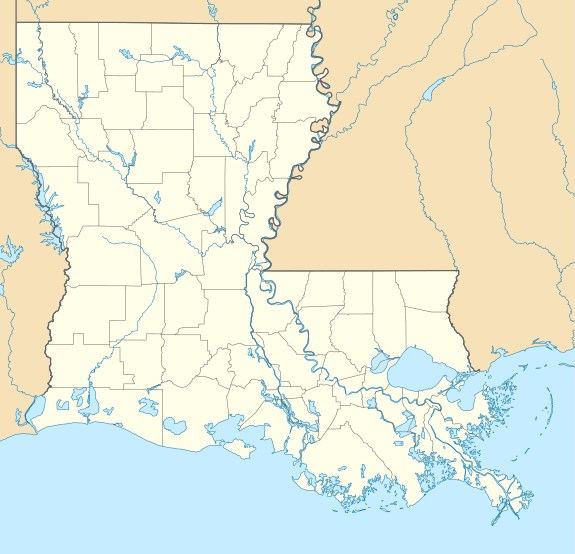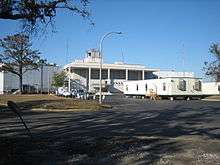Lakefront Airport
Lakefront Airport (IATA: NEW[2], ICAO: KNEW, FAA LID: NEW) is a public use airport located four nautical miles (5 mi, 7 km) northeast of the central business district of New Orleans, in Orleans Parish, Louisiana, United States.[1] Owned by the Orleans Levee District,[1] it is included in the National Plan of Integrated Airport Systems for 2011–2015, which categorized it as a general aviation reliever airport.[3]
Lakefront Airport (former New Orleans Army Air Base) | |||||||||||||||||||
|---|---|---|---|---|---|---|---|---|---|---|---|---|---|---|---|---|---|---|---|
 USGS 2006 orthophoto | |||||||||||||||||||
Lakefront Airport, main terminal, 2010 | |||||||||||||||||||
| Summary | |||||||||||||||||||
| Airport type | Public | ||||||||||||||||||
| Owner | Orleans Levee District | ||||||||||||||||||
| Serves | New Orleans, Louisiana | ||||||||||||||||||
| Elevation AMSL | 7 ft / 2 m | ||||||||||||||||||
| Coordinates | 30°02′33″N 090°01′42″W | ||||||||||||||||||
| Website | http://www.lakefrontairport.com/ | ||||||||||||||||||
| Map | |||||||||||||||||||
 NEW Location of airport in Louisiana | |||||||||||||||||||
| Runways | |||||||||||||||||||
| |||||||||||||||||||
| Statistics (2016) | |||||||||||||||||||
| |||||||||||||||||||
Originally the major commercial airport in the New Orleans area, Lakefront Airport relinquished that role in 1946 when commercial airline service began from Moisant International Airport (now known as Louis Armstrong International Airport), a significantly larger facility located in the nearby suburb of Kenner. Lakefront Airport continues to serve as a general aviation airport with charter, private, and occasional military operations taking place. Commercial airline service is also available to destinations within the Gulf South Region. The terminal building's interior retains much of its original lavish 1930s decoration, and the art deco exterior, obscured for decades by a "bomb-proof" facade installed after World War II, has recently been returned to its original appearance. The terminal building houses a restaurant frequented by nearby residents, the Walnut Room. The sculpture installation in front of the terminal, "Fountain of the Winds" by Enrique Alferez, is a local landmark.
Lakefront Airport was damaged by hurricane-force winds and the storm surge of Hurricane Katrina in 2005, and a number of the hangars and outlying buildings were destroyed. While the airport soon resumed functioning, restoration of the terminal building and other facilities proceeds slowly. With the exterior of the main terminal fully restored, however, the classic Art Deco building was used as the headquarters of the fictional company Ferris Aircraft in the 2011 action hero film Green Lantern starring Ryan Reynolds and Blake Lively.
The New Orleans Lakefront Airport has also hosted since 2014 the WWII Air, Sea & Land Festival. The three-day airshow hosted by the National WWII Museum, Commemorative Air Force, and the Greater New Orleans Sports Foundation honor the men and women of WWII through aviation displays, vehicle displays, and WWII re-enactments.
History
Airport construction began in 1929 by orders of Huey Long, on a man-made peninsula dredged by the Orleans Levee Board, jutting into Lake Pontchartrain on the Eastern New Orleans side of the Industrial Canal. It was designed by New Orleans architect Leon C. Weiss and his architectural firm Weiss, Dreyfous and Seiferth, which also designed the Louisiana State Capitol. It was originally named Shushan Airport after Levee Board president and Long ally Abraham Shushan. The airport was inaugurated on 10 February 1934. Visitors noticed that every doorknob, window sill, countertop, and plumbing fixture either had the name or the initials of Abe Shushan.[4][5] After Shushan's name was tarnished from involvement in the Louisiana Scandals of the late 1930s, the airport was renamed New Orleans Airport in 1939.[6]
The assigned airport code "NEW" is retained despite its current "Lakefront Airport" name.

During World War II, the airfield was used by the United States Army Air Forces and housed the Tropical Weather School in 1945.
At the start of the 1960s, thick concrete panels were added to the main terminal building to turn it into a Cold War era bomb shelter.
Ammunition manufacturer Joyce Hornady was killed in a Piper Aztec on January 15, 1981.[7] The aircraft, with Hornady at the controls flying in heavy fog, crashed into Lake Pontchartrain while on final approach to Lakefront Airport.[8]
Lakefront Airport was badly damaged by storm surge during Hurricane Katrina in 2005, and again during Hurricane Isaac in 2012. While the airport was quickly brought back to service, many facilities remained in temporary trailers for years after Katrina.
On January 23, 2010, a United States Navy Beechcraft T-34 Mentor training aircraft crashed into Lake Ponchartrain just over one mile from the approach end of the airport. The aircraft was intending to land at Naval Air Station-Joint Reserve Base New Orleans but diverted to Lakefront Airport due to weather. The student pilot on board survived, however, the instructor drowned. According to official reports, the aircrew lost track of their altitude which resulted in their ditching in the lake.
Post-Katrina reconstruction at the airport has included restoration of the main terminal building's original Art Deco facade. The Art Deco interior and restoration of the Shushan terminal is being filmed for a television documentary titled, Return Flight. Filming began in 2012 and will conclude in 2013 when the restoration draws to a close.[9]
Facilities and aircraft
Lakefront Airport covers an area of 473 acres (191 ha) at an elevation of 7 feet (2 m) above mean sea level. It has three asphalt paved runways: 18R/36L is 6,879 by 150 feet (2,097 x 46 m); 18L/36R is 3,697 by 75 feet (1,127 x 23 m); 9/27 is 3,114 by 75 feet (949 x 23 m).[1]
For the 12-month period ending July 19, 2016, the airport had 60,778 aircraft operations, an average of 166 per day: 91% general aviation, 3% military, and 6% air taxi. At that time there were 125 aircraft based at this airport: 62% single-engine, 18% multi-engine, 15% jet, and 6% helicopter.[1]
In Popular Culture
The airport was used as a location in the 1973 James Bond film Live and Let Die.[10]
The airport was the filming location of the film The Green Lantern starring Ryan Reynolds and Blake Lively.
References
- FAA Airport Master Record for NEW (Form 5010 PDF). Federal Aviation Administration. Effective March 2, 2017.
- "IATA Airport Code Search (NEW: Lakefront)". International Air Transport Association. Retrieved August 13, 2013.
-
"2011–2015 NPIAS Report, Appendix A" (PDF). National Plan of Integrated Airport Systems. Federal Aviation Administration. October 4, 2010. Archived from the original (PDF, 2.03 MB) on September 27, 2012. External link in
|work=(help) - Brinkley, Alan "Voices of Protest" (Random House, 1882)30
- "Story of the former name Shushan Airport". April 5, 2005. Archived from the original on April 18, 2005.
- Zwoll, Wayne van (2011). Shooter's Bible Guide to Rifle Ballistics. Skyhorse Publishing Company, Incorporated. pp. 184–185. ISBN 978-1-62087-285-7.
- "A twin-engine plane carrying three people on a flight from Nebraska crashed into Lake Pontchartrain in heavy fog Thursday while on approach to New Orleans Lakefront Airport". upi.com/archives. January 15, 1981. Retrieved October 18, 2018.
- "New Orleans Lakefront Airport". lakefrontairport.com. Retrieved 2019-09-27.
- Moore, Roger & Hedison, David. The 007 Diaries: Filming Live and Let Die. The History Press, June 2018. ISBN 978-0750987592
External links
| Wikimedia Commons has media related to New Orleans Lakefront Airport. |
- New Orleans Lakefront Airport, official site
- Fixed-base operators (FBOs): Flightline First, Hawthorne, Landmark Aviation
- Aerial image as of December 2002 from USGS The National Map
- FAA Airport Diagram for NEW (PDF), effective August 13, 2020
- FAA Terminal Procedures for NEW, effective August 13, 2020
- Resources for this airport:
- FAA airport information for NEW
- AirNav airport information for KNEW
- ASN accident history for NEW
- FlightAware airport information and live flight tracker
- NOAA/NWS weather observations: current, past three days
- SkyVector aeronautical chart, Terminal Procedures